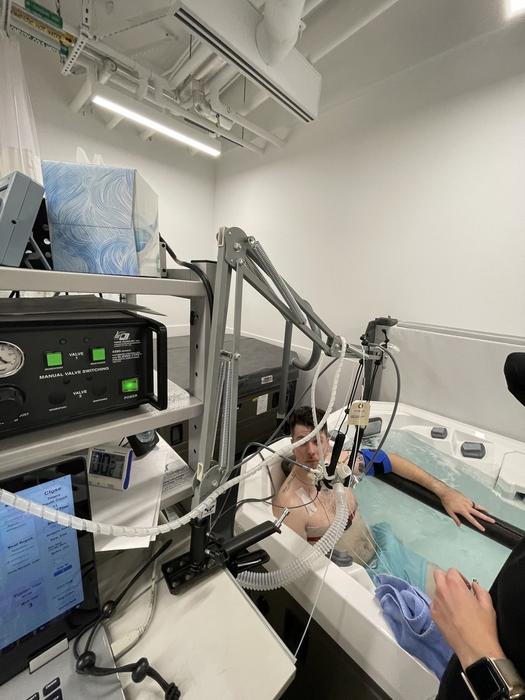In the realm of passive heat therapies, a groundbreaking study from the University of Oregon’s Bowerman Sports Science Center sheds new light on the physiological benefits of hot tubs compared to traditional and far-infrared saunas. While both modalities have long been cherished for muscle relaxation and warmth, this research draws a clear distinction in their acute impacts on the human body, revealing that immersion in hot water may provide superior health outcomes through mechanisms not previously fully appreciated.
The study rigorously evaluated the effects of three common heat treatment methods—hot tub soaking, dry heat sauna exposure, and far-infrared sauna sessions—on thermoregulatory, cardiovascular, and immune system responses. By elevating core body temperature, these passive heating approaches aim to mimic some of the stressors induced by physical exercise, which is known to confer numerous health benefits. Yet, until now, a direct comparison of these therapies’ acute physiological impacts under controlled laboratory conditions was missing from the scientific literature.
Under the leadership of Christopher Minson, a recognized authority in human physiology, researchers enrolled twenty healthy adults aged 20 to 28 who engaged in regular physical activity. The controlled environment ensured that the physiological responses measured could be attributed primarily to the mode of heat exposure rather than confounding lifestyle factors. Throughout the interventions, precise measurements of core temperature, blood pressure, heart rate, cardiac output, circulating immune cells, and biomarkers of inflammation were taken, providing a comprehensive profile of the body’s acute reaction to each heating method.
The findings revealed that immersion in hot water elicited the most profound increase in core body temperature compared to both traditional dry heat and far-infrared saunas. This elevated core temperature serves as a critical trigger for downstream physiological processes, including enhanced blood flow and improved vascular function. The physical properties of water, with its high thermal conductivity and the imposed physical restriction of the body’s sweat mechanisms, limit heat dissipation, allowing for more efficient and sustained thermal loading.
This sustained rise in internal temperature was directly correlated with significant cardiovascular responses. Increased cardiac output during hot water immersion indicated a heightened demand on the heart to pump blood throughout the vascular system, promoting vascular shear stress—an important stimulus for endothelial health and nitric oxide production. Such responses are understood to contribute to long-term reductions in arterial stiffness and lower resting blood pressure, key markers of cardiovascular health.
Moreover, the immunological profile following hot tub immersion diverged notably from that observed after sauna sessions. Specifically, only hot water immersion triggered a measurable inflammatory response characterized by increased levels of inflammatory cytokines and dynamic shifts in immune cell populations. These signaling molecules play a pivotal role in mobilizing the immune system and may underpin some of the health-enhancing effects attributed to heat therapy, including enhanced resistance to infection and improved recovery from muscle injury.
Jessica Atencio, the study’s lead author, emphasizes the physiological basis for these distinct responses. The surrounding air in saunas facilitates evaporative cooling through sweating, which acts as a natural thermoregulation mechanism, effectively moderating the rise in core temperature. In contrast, when submerged, the body struggles to dissipate heat efficiently, causing a more robust and sustained hyperthermic stimulus. This unique thermal challenge provokes a more intense cardiovascular and immune response, arguably positioning hot tub therapy as a more potent modality for eliciting therapeutic heat stress.
Heat therapy, as studied here, does not only offer acute physiological benefits but may also contribute to chronic adaptations when practiced consistently and safely. The concept parallels exercise-induced conditioning, where repeated exposure to moderate stressors gradually enhances system resilience and function. For individuals unable or unwilling to maintain traditional exercise routines due to injury, illness, or lifestyle constraints, heat therapy emerges as a promising adjunct or alternative to maintain health and wellness.
Minson’s extensive research over the past two decades underscores the potential alignment of regular passive heating with various health outcomes, including improved vascular health, metabolic function, and immune competence. However, he cautions that safety and medical clearance remain paramount, particularly for populations with preexisting conditions. Proper guidance ensures that heat therapy is tailored to individual tolerance levels, minimizing risks while maximizing benefits.
Beyond the physiological, heat therapies hold cultural, social, and even spiritual significance in many societies worldwide. Saunas and hot tubs are often integral to communal rituals, relaxation, and mindfulness practices. Minson highlights that these psychosocial components may synergistically contribute to the overall health benefits observed, reinforcing the holistic value of heat therapy beyond mere biological mechanisms.
This study sets a new benchmark in passive heat therapy research by providing a scientifically controlled, comparative analysis of commonly used modalities. Its insights pave the way for more personalized and effective therapeutic strategies that leverage the unique properties of hot water immersion and sauna technologies. As interest grows in nonpharmacological interventions for health maintenance and disease prevention, such evidence-based guidance is invaluable.
With the increasing prevalence of sedentary lifestyles and chronic disease, the accessibility and practicality of heat therapy may offer a much-needed complement to traditional exercise paradigms. The ability to induce cardiovascular, thermoregulatory, and immune system adaptations through controlled heat exposure presents a compelling avenue for enhancing public health, particularly when combined with existing lifestyle modifications.
As the scientific community continues to unravel the complexities of heat-induced physiological adaptations, this latest research from the University of Oregon serves as a clarion call to reconsider how we integrate passive heating into health promotion. Whether viewed through the lens of exercise physiology, immunology, or psychosocial well-being, hot tub immersion stands out as a potent and multifaceted intervention with enduring potential.
Subject of Research:
Comparison of thermoregulatory, cardiovascular, and immune responses to different passive heat therapy modalities
Article Title:
Comparison of thermoregulatory, cardiovascular, and immune responses to different passive heat therapy modalities
News Publication Date:
9-Jun-2025
Web References:
http://dx.doi.org/10.1152/ajpregu.00012.2025
Image Credits:
Minson Lab, University of Oregon
Keywords:
Human physiology, passive heat therapy, thermoregulation, cardiovascular health, immune response, hot tub, sauna, hyperthermia




